National Hazards Vulnerability and the Remediation, Restoration and Revitalization of Contaminated Sites—2. RCRA Sites
Abstract
1. Introduction
|
|
2. Methods
- (1)
- Location and extraction of the latest RCRA site information (name and location) from EPA’s Facility Registry Service (FRS) for all active sites [12];
- (2)
- Location and extraction of the 2018 county boundary and 2015 core-based statistical area information with population estimates from the US Census;
- (3)
- Location and extraction of 2000–2015 natural hazard exposure information for the twelve natural hazards listed above from the EPA’s Cumulative Resilience Screening Index (CRSI) database [19];
- (4)
- Normalization of exposure estimates for each type of natural hazard on a 0–100 scale (data were reviewed to ascertain if outliers were present which might skew the distribution; no outliers were determined);
- (5)
- Merging of these sets of information based on a common spatial scale (i.e., county); and,
- (6)
- Mapping of the merged information to depict the RCRA site location with the highest exposure for each hazard type and the integration of all twelve hazards, and potential level of impact of the highest exposures at core-based statistical areas of varying population.
3. Results
4. Discussion
5. Conclusions
Author Contributions
Funding
Institutional Review Board Statement
Data Availability Statement
Disclaimer
Conflicts of Interest
References
- Binder, S.; Sanderson, L.M. The role of the epidemiologist in natural disasters. Ann. Emerg. Med. 1987, 16, 1081–1084. [Google Scholar] [CrossRef]
- Cruz, A.M.; Steinberg, L.J.; Luna, R. Identifying Hurricane-Induced Hazardous Material Release Scenarios in a Petroleum Refinery. Nat. Hazards Rev. 2001, 2, 203–210. [Google Scholar] [CrossRef]
- Pielke, R.A., Jr.; Gratz, J.; Landsea, C.W.; Collins, D.; Saunders, M.A.; Musulin, R. Normalized hurricane damage in the United States: 1900–2005. Nat. Hazards Rev. 2008, 9, 29–42. [Google Scholar] [CrossRef]
- Turetsky, M.R.; Harden, J.W.; Friedli, H.R.; Flannigan, M.; Payne, N.; Crock, J.; Radke, L.; Flannigan, M.D. Wildfires threaten mercury stocks in northern soils. Geophys. Res. Lett. 2006, 33, 16403. [Google Scholar] [CrossRef]
- Rothwell, J.J.; Evans, M.; Liddaman, L.; Allott, T. The role of wildfire and gully erosion in particulate Pb export from contaminated peatland catchments in the southern Pennines, U.K. Geomorphology 2007, 88, 276–284. [Google Scholar] [CrossRef]
- Evangeliou, N.; Balkanski, Y.; Cozic, A.; Hao, W.M.; Møller, A.P. Wildfires in Chernobyl-contaminated forests and risks to the population and the environment: A new nuclear disaster about to happen? Environ. Int. 2014, 73, 346–358. [Google Scholar] [CrossRef]
- Showalter, P.S.; Myers, M.F. Natural Disasters as the Cause of Technological Emergencies: A Review of the Decade 1980–1989; Natural Hazards Research Center: Boulder, CO, USA, 1992. [Google Scholar]
- Showalter, P.S.; Myers, M.F. Natural disasters in the United States as release agents of oil, chemicals, or radiological materials between 1980–1989. Analysis and recommendations. Risk Anal. 1994, 14, 169–182. [Google Scholar] [CrossRef]
- Krausmann, E.; Cruz, A.M.; Affeltranger, B. The impact of the 12 May 2008 Wenchuan earthquake on industrial facilities. J. Loss Prev. Process. Ind. 2010, 23, 242–248. [Google Scholar] [CrossRef]
- Penning-Rowsell, E.C.; Smith, K. Environmental Hazards: Assessing Risk and Reducing Disaster. Geogr. J. 1993, 159, 349. [Google Scholar] [CrossRef]
- Associated Press Judge OKs Deal Over Katrina-Related Oil Spill. Available online: http://www.msnbc,com/id/16892313/ns/us_news-life/t/judge-oks-deal-over-katrina-related-oil-spill/ (accessed on 30 January 2007).
- U.S. Environmental Protection Agency (U.S. EPA). Resource Conservation and Recovery Act (RCRA) Overview. 2020. Available online: https://www.epa.gov/rcra/resource-conservation-and-recovery-act-rcra-overview (accessed on 20 November 2020).
- Gaba, J.M. Solid waste and recycled materials under RCRA: Separating chaff from wheat. Ecol. Law Q. 1989, 16, 623–666. [Google Scholar]
- Wright, P.R. Testimony before the U.S. House Committee on Appropriations, Interior, Environment and Related Agencies Subcommittee. Available online: https://www.epa.gov/sites/production/files/2020-02/documents/epa-wright_testimony-feb_5_2020_hac_recycling_hearing.pdf (accessed on 5 February 2020).
- Summers, J.K.; Lamper, A.; Buck, K. National Hazards Vulnerability and the Remediation, Restoration and Revitalization of Contaminated Sites—1. Superfund. Environ. Manag. 2020. Submitted for Publication. [Google Scholar]
- Summers, J.K.; Smith, L.M.; Harwell, L.C.; Buck, K.D. Conceptualizing holistic community resilience to climate events: Foundation for a climate resilience screening index. GeoHealth 2017, 1, 151–164. [Google Scholar] [CrossRef] [PubMed]
- Summers, J.K.; Harwell, L.C.; Buck, K.D.; Smith, L.M.; Vivian, D.N.; Bousquin, J.J.; Harvey, J.E.; Hafner, S.F.; McLaughlin, M.D. Resilience Screening Index (CRSI): An Assessment of Resilience to Acute Meteorological Events and Natural Hazard; EPA600/R-17/238; U.S. Environmental Protection Agency: Washington, DC, USA, 2017.
- Summers, K.; Harwell, L.C.; Smith, L.M.; Buck, K.D. Measuring Community Resilience to Natural Hazards: The Natural Hazard Resilience Screening Index (NaHRSI)-Development and Application to the United States. GeoHealth 2018, 2, 372–394. [Google Scholar] [CrossRef] [PubMed]
- Summers, J.K.; Harwell, L.C.; Buck, K.D.; Smith, L.M.; Vivian, D.N.; Bousquin, J.J.; Harvey, J.E.; Hafner, S.F.; McLaughlin, M.D.; McMillion, C.A. Development of a Cumulative Resilience Screening Index (CRSI) for Natural Hazards: An Assessment of Resilience to Acute Meteorological Events and Selected Natural Hazards; EPA600/R-20/xxx; U.S. Environmental Protection Agency: Washington, DC, USA, 2020.
- ARUP. City Resilience Framework; The Rockefeller Foundation; ARUP Development International: New York, NY, USA, 2014. [Google Scholar]
- Melillo, J.M.; Richmond, T.; Yohe, G.W. Climate Change Impacts in the 11 United States: The Third National Climate Assessment. U.S. Global Change Research Program, 12. 2014. Available online: http://nca2014.globalchange.gov/report (accessed on 20 November 2020).
- Maco, B.; Bardos, P.; Coulon, F.; Erickson-Mulanax, E.; Hansen, L.J.; Harclerode, M.; Hou, D.; Mielbrecht, E.; Wainwright, H.M.; Yasutaka, T.; et al. Resilient remediation: Addressing extreme weather and climate change, creating community value. Remediat. J. 2018, 29, 7–18. [Google Scholar] [CrossRef]
- Burger, J.; Gochfeld, M. Initiating events, functional remediation, and assessment of risk to ecological resources. Ecol. Indic. 2016, 71, 32–40. [Google Scholar] [CrossRef]
- Pease, P.; Lecce, S.; Gares, P.; Rigsby, C. Heavy metal concentrations in sediment deposits on the Tar River floodplain following Hurricane Floyd. Environ. Earth Sci. 2006, 51, 1103–1111. [Google Scholar] [CrossRef]
- Hooda, P.S.; Alloway, B.J. Effects of time and temperature on the bioavailability of Cd and Pb from sludge-amended soils. J. Soil Sci. 1993, 44, 97–110. [Google Scholar] [CrossRef]
- Nadal, M.; Marquès, M.; Mari, M.; Domingo, J.L. Climate change and environmental concentrations of POPs: A review. Environ. Res. 2015, 143, 177–185. [Google Scholar] [CrossRef]
- Buck, K.D.; Summers, K.J.; Hafner, S.; Smith, L.M.; Harwell, L.C.; Summers, J.K. Development of a Multi-Hazard Landscape for Exposure and Risk Interpretation: The PRISM Approach. Curr. Environ. Eng. 2019, 6, 74–94. [Google Scholar] [CrossRef]
- Homer, C.; Dewitz, J.; Yang, L.; Jin, S.; Danielson, P.; Xian, G.; Coulston, J.; Herold, N.; Wickham, J.; Megown, K. Completion of the 2011 National Land Cover Database for the conterminous United States-Representing a decade of land cover change information. Photogramm. Eng. Remote Sens. 2015, 81, 345–354. [Google Scholar]
- U.S. Environmental Protection Agency. Guidance for Remediation Waste Management at Resource Conservation and Recovery Act (RCRA) Corrective Action Sites. 2020. Available online: https://www.epa.gov/hw/guidance-remediation-waste-management-resource-conservation-and-recovery-act-rcra-corrective (accessed on 21 November 2020).
- U.S. Environmental Protection Agency. Learn about Corrective Action. 2020. Available online: https://www.epa.gov/hw/learn-about-corrective-action#vmg2030 (accessed on 21 November 2020).
- GAO (U.S. Government Accounting Office). Hazardous Waste Sites: Improved Effectiveness of Controls at Sites Could Better Protect the Public. GAO-05-163. 2005. Available online: https://www.gao.gov/assets/250/245140.pdf (accessed on 23 November 2020).
- GAO (U.S. Government Accounting Office). Hazardous and Nonhazardous Waste: Demographics of People Living Near Waste Facilities. GAO/RCED-95-84. 1995. Available online: https://www.gao.gov/assets/160/155134.pdf (accessed on 23 November 2020).
- Princeton University, Engineering School. Increasing flood risk: ‘100-year‘ floods will happen every 1 to 30 years, according to new flood maps. Sci. Dly. 2019. Available online: www.sciencedaily.com/releases/2019/08/190822165010.htm (accessed on 22 November 2020).
- Marsooli, R.; Lin, N.; Emanuel, K.; Feng, K. Climate change exacerbates hurricane flood hazards along US Atlantic and Gulf Coasts in spatially varying patterns. Nat. Commun. 2019, 10, 1–9. [Google Scholar] [CrossRef] [PubMed]
- Memphis Area Association of Governments. Shelby County Solid Waste Needs Assessment. 2019. Available online: https://maagov.org/wp-content/uploads/2019/03/Shelby_NA_1_18-Revised-3.7.19.pdf (accessed on 23 November 2020).
- Federal Emergency Management Agency (FEMA). Available online: www.floodsmart.gov (accessed on 8 November 2020).
- Federal Emergency Management Agency (FEMA). Drive-thru Disaster Recovery Centers Opening in Rapides and Winn Parishes. 2020. Available online: https://www.fema.gov/press-release/20200919/drive-thru-disaster-recovery-centers-opening-rapides-and-winn-parishes (accessed on 22 November 2020).
- Charleston County Government Emergency Operations Plan. 2020. Available online: https://www.charlestoncounty.org/departments/emergency-management/files/EOP.pdf (accessed on 21 November 2020).
- Pugh, C.; Whung, P.Y.; Barber, J.; Essoka, J.; Priester, N. EPA Research Highlights -Research to Advance Community Resilience. Em—The Magazine for Environmental Managers. 2019. Available online: https://www.epa.gov/sites/production/files/2019-09/documents/research_to_advance_community_resilience.pdf (accessed on 19 November 2020).
- US Climate Change Science Program (CCSP). Weather and Climate Extremes in a Changing Climate, Regions of Focus: North America, Hawaii, Caribbean, and U.S. Pacific Islands, Synthesis and Assessment Product 3.3. 2008. Available online: http://www.climatescience.gov/Library/sap/sap3-3/final-report/default.htm (accessed on 20 November 2020).
- Science Daily. Tornados, Flooding May Warn of Climate Change. Available online: http://www.sciencedaily.com/releases/2008/06/08062231312.htm (accessed on 22 November 2020).
- Mooney, C. Is climate change causing an upsurge in US tornadoes? Available online: https://www.newscientist.com/article/mg19926671-800-is-climate-change-causing-an-upsurge-in-us-tornadoes/ (accessed on 21 November 2020).
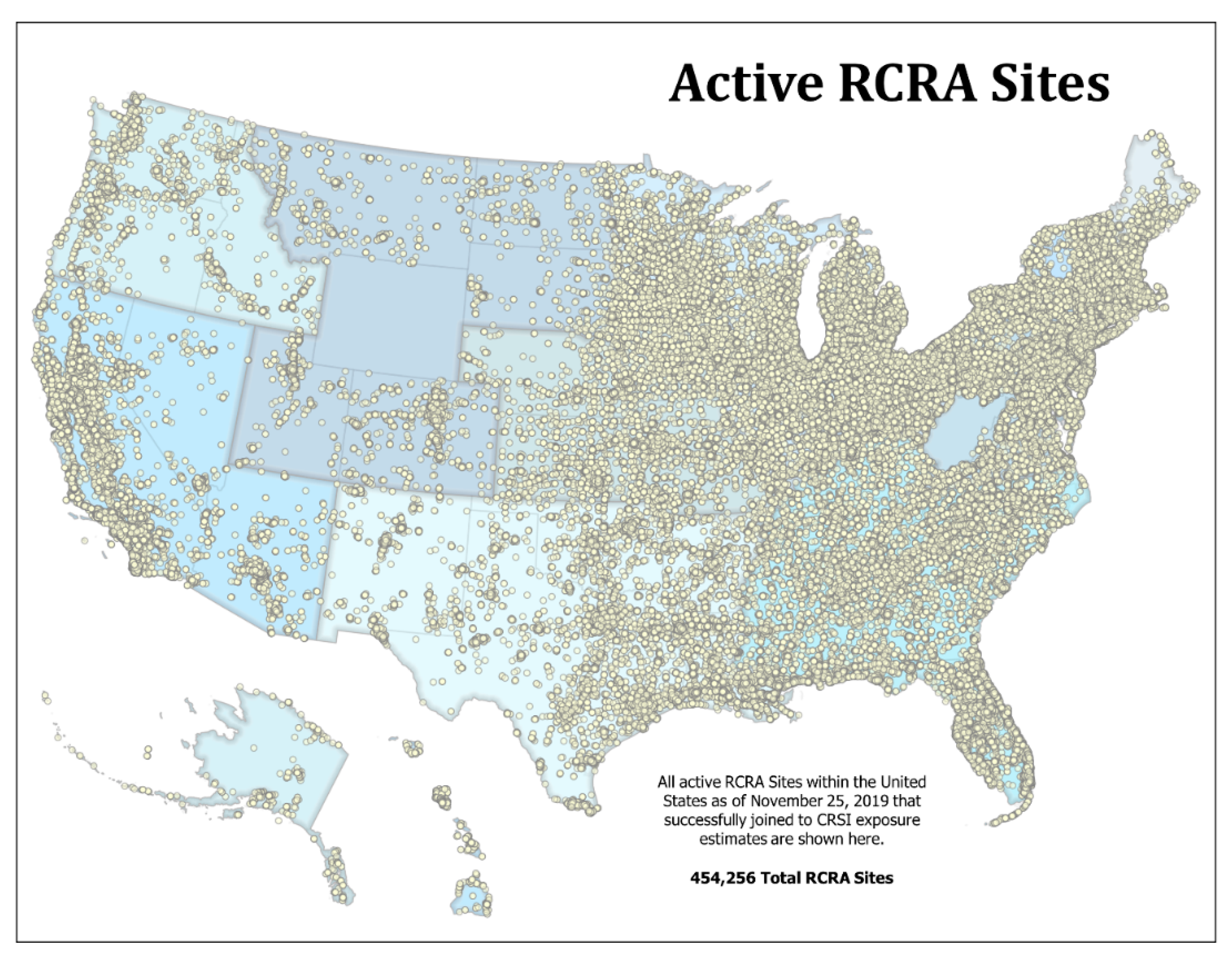
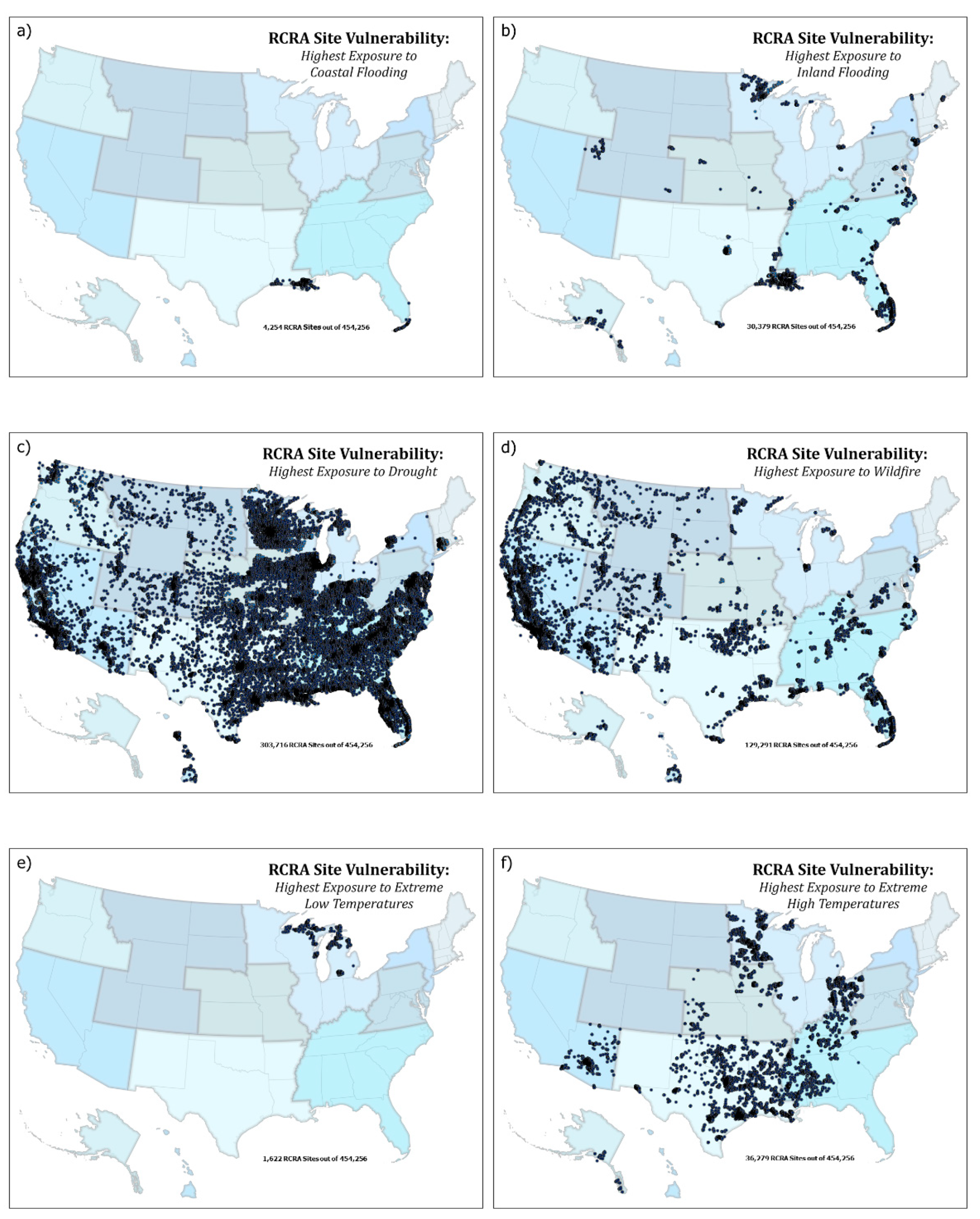
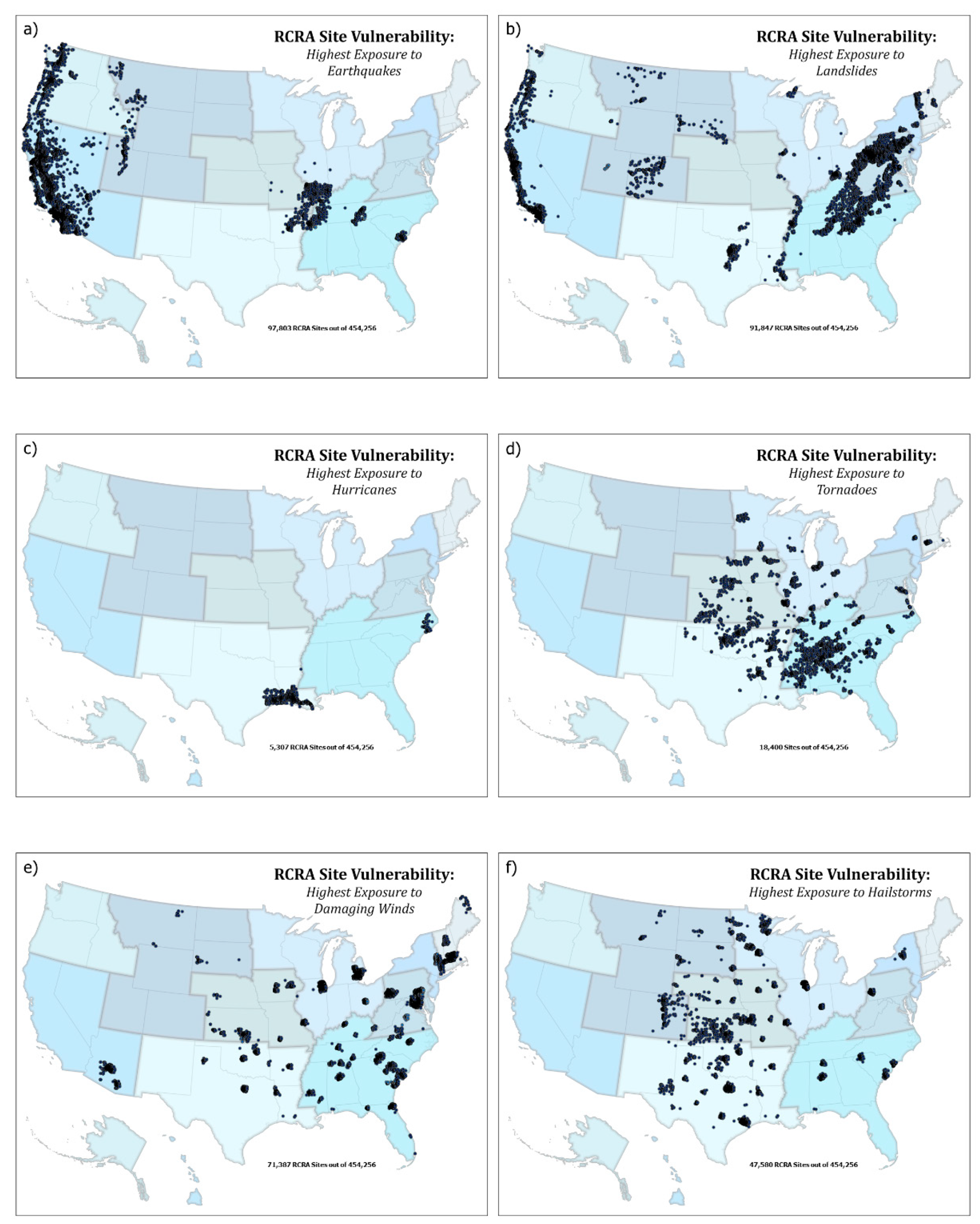

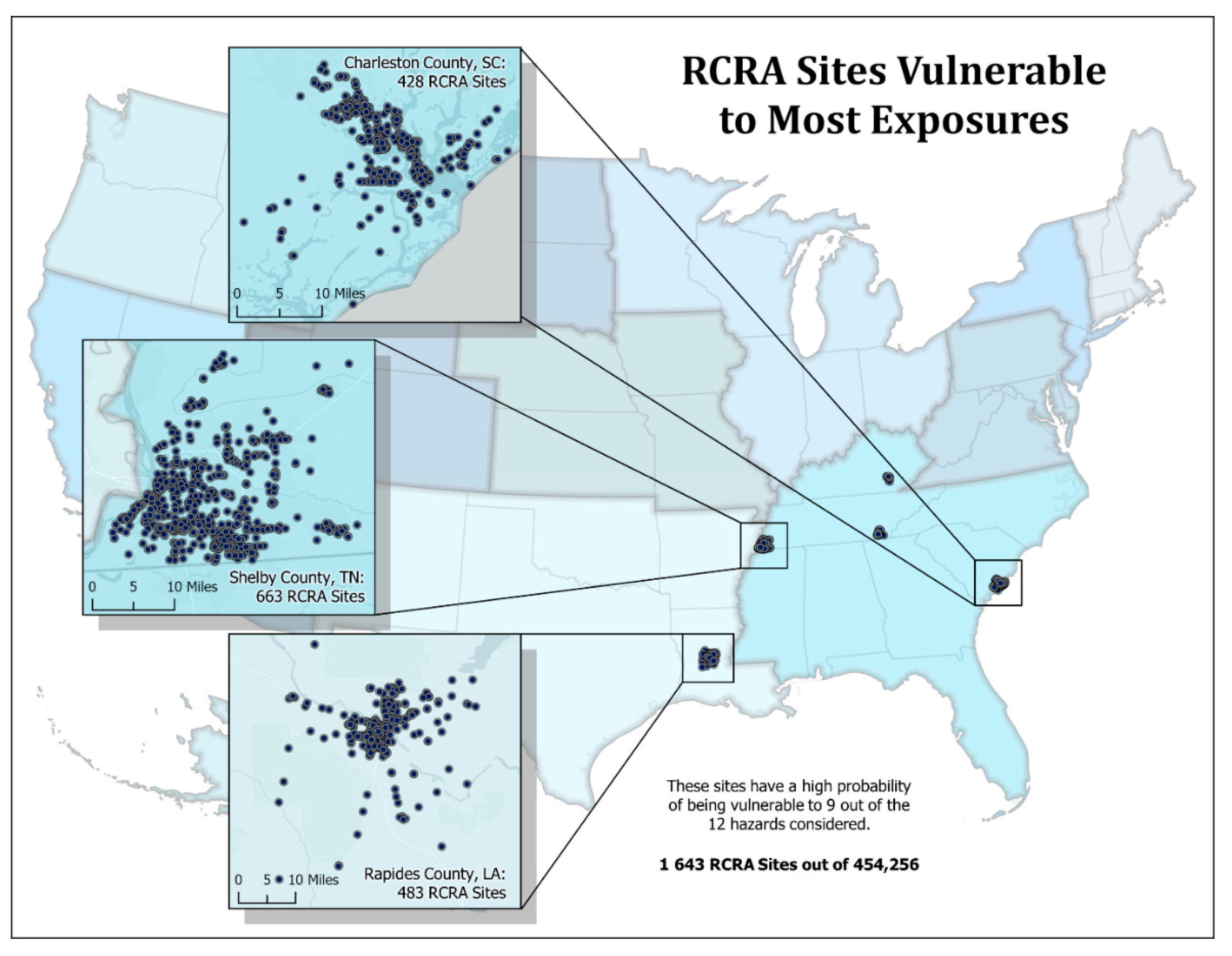
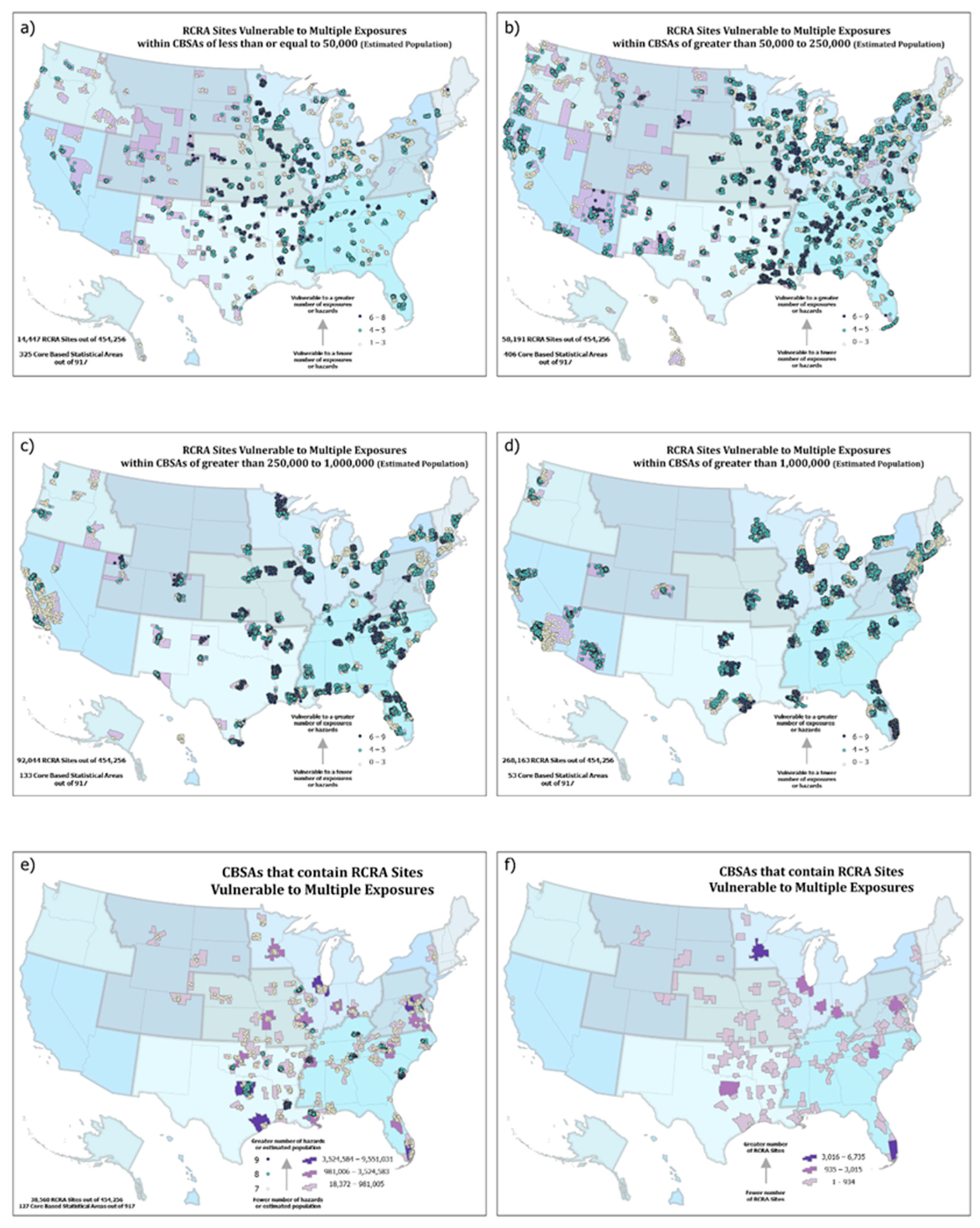
| Natural Hazard Type | Number of RCRA Sites Vulnerable to Natural Hazard Type | Percentage of RCRA Sites Vulnerable to Natural Hazard Type |
|---|---|---|
| Coastal Flooding | 122,852 | 27.04% |
| Drought | 404,542 | 89.06% |
| Earthquakes | 113,810 | 25.05% |
| Hail | 418,151 | 92.05% |
| Hurricanes | 50,068 | 11.02% |
| Inland Flooding | 450,733 | 99.22% |
| Landslides | 234,335 | 51.58% |
| High Temperature Extremes | 454,220 | 99.99% |
| Low Temperature Extremes | 454,183 | 99.98% |
| Tornadoes | 261,782 | 57.63% |
| Wildfires | 210,565 | 46.35% |
| Wind Events | 431,718 | 95.04% |
| Multiple Natural Hazards | 454,224 | 99.99% |
| Hazard | Score Class | Number of Sites | Percentage of Sites | Hazard | Score Class | Number of Sites | Percentage of Sites |
|---|---|---|---|---|---|---|---|
| Coastal Flooding | 1 | 109,753 | 89.34% | Drought | 1 | 8095 | 2.00% |
| 2 | 6610 | 5.38% | 2 | 80,138 | 19.81$ | ||
| 3 | 2235 | 1.82% | 3 | 12,593 | 3.11% | ||
| 4 | 4254 | 3.46% | 4 | 303,716 | 75.08% | ||
| ALL | 122,852 | 100.00% | ALL | 404,542 | 100.00% | ||
| Earthquakes | 1 | 3651 | 3.21% | Hail | 1 | 230,643 | 55.16% |
| 2 | 7171 | 6.30% | 2 | 106,550 | 25.48% | ||
| 3 | 5185 | 4.56% | 3 | 33,378 | 7.98% | ||
| 4 | 97,803 | 85.94% | 4 | 47,580 | 11.38% | ||
| ALL | 113,810 | 100.00% | ALL | 418,151 | 100.00% | ||
| Hurricanes | 1 | 5095 | 10.18% | Inland Flooding | 1 | 84,822 | 18.82% |
| 2 | 35,554 | 71.01% | 2 | 251,244 | 55.74% | ||
| 3 | 4112 | 8.21% | 3 | 84,288 | 18.70% | ||
| 4 | 5307 | 10.60% | 4 | 30,379 | 6.74% | ||
| ALL | 50,068 | 100.00% | ALL | 450,733 | 100.00% | ||
| Landslides | 1 | 83,211 | 35.51% | Temperature (H) | 1 | 41,187 | 9.07% |
| 2 | 40,112 | 17.12% | 2 | 117,421 | 25.85% | ||
| 3 | 19,165 | 8.18% | 3 | 259,374 | 57.10% | ||
| 4 | 91,847 | 39.19% | 4 | 36,238 | 7.98% | ||
| ALL | 234,335 | 100.00% | ALL | 454,220 | 100% | ||
| Temperature (L) | 1 | 83,324 | 18.35% | Tornadoes | 1 | 201,187 | 76.85% |
| 2 | 200,406 | 44,12% | 2 | 30,575 | 11.68% | ||
| 3 | 168,831 | 37.17% | 3 | 11,620 | 4.44% | ||
| 4 | 1622 | 0.36% | 4 | 18,400 | 7.03% | ||
| ALL | 454,183 | 100.00% | ALL | 261,782 | 100.00% | ||
| Wildfires | 1 | 62,166 | 29.52% | Wind Events | 1 | 166,606 | 38.59% |
| 2 | 9618 | 4.57% | 2 | 120,699 | 27.96% | ||
| 3 | 9490 | 4.51% | 3 | 73,026 | 16.92% | ||
| 4 | 129,291 | 61.40% | 4 | 71,387 | 16.54% | ||
| ALL | 210,565 | 100.00% | ALL | 431,718 | 100.00% | ||
| All Hazards | 1 | 2792 | 0.61% | CRSI Risk Domain Score | 1 | 100,559 | 22.14% |
| 2 | 81,436 | 17.93% | 2 | 125,590 | 27.65% | ||
| 3 | 242,490 | 53.39% | 3 | 202970 | 44.69% | ||
| 4 | 127,506 | 28.07% | 4 | 25,073 | 5.52% | ||
| ALL | 454,224 | 100.00 | ALL | 454,192 | 100.00% | ||
| CRSI Score | 1 | 452,856 | 99.69% | ||||
| 2 | 1155 | 0.25% | |||||
| 3 | 106 | 0.02% | |||||
| 4 | 139 | 0.03% | |||||
| ALL | 454,256 | 100.00% |
Publisher’s Note: MDPI stays neutral with regard to jurisdictional claims in published maps and institutional affiliations. |
© 2021 by the authors. Licensee MDPI, Basel, Switzerland. This article is an open access article distributed under the terms and conditions of the Creative Commons Attribution (CC BY) license (http://creativecommons.org/licenses/by/4.0/).
Share and Cite
Summers, K.; Lamper, A.; Buck, K. National Hazards Vulnerability and the Remediation, Restoration and Revitalization of Contaminated Sites—2. RCRA Sites. Sustainability 2021, 13, 965. https://doi.org/10.3390/su13020965
Summers K, Lamper A, Buck K. National Hazards Vulnerability and the Remediation, Restoration and Revitalization of Contaminated Sites—2. RCRA Sites. Sustainability. 2021; 13(2):965. https://doi.org/10.3390/su13020965
Chicago/Turabian StyleSummers, Kevin, Andrea Lamper, and Kyle Buck. 2021. "National Hazards Vulnerability and the Remediation, Restoration and Revitalization of Contaminated Sites—2. RCRA Sites" Sustainability 13, no. 2: 965. https://doi.org/10.3390/su13020965
APA StyleSummers, K., Lamper, A., & Buck, K. (2021). National Hazards Vulnerability and the Remediation, Restoration and Revitalization of Contaminated Sites—2. RCRA Sites. Sustainability, 13(2), 965. https://doi.org/10.3390/su13020965




